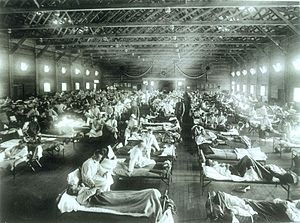In depth
studies of the evolution of the influenza virus have shown interesting trends.
The strains tend to group in clusters rather than form a continuous antigenic
lineage. This is based on the seasonal immunizations, which select against
certain strains. There is a selective advantage for clusters farthest from
those in the vaccination.
 The quick
evolution of influenza poses a seemingly endless battle to the immune system.
Influenza epidemics are estimated to cause 500,000 deaths worldwide per year. Certain
strains of influenza have made their mark on human history by proving
particularly fatal. These include the Spanish flu of 1918 that killed an
estimated 50 million people worldwide, the Asian flu of 1957 that killed 2
million people, the Hong Kong flu in 1968 that killed 1 million people, and the
swine flu of 2009, which killed an estimated 295,000 people. The global impact
of this virus proves the importance of predicting its evolution to the best of
our abilities in order to develop effective vaccinations. However, much of the
evolution of influenza is due to random and unpredictable reassortments and
genetic drifts, thereby making this task difficult.
The quick
evolution of influenza poses a seemingly endless battle to the immune system.
Influenza epidemics are estimated to cause 500,000 deaths worldwide per year. Certain
strains of influenza have made their mark on human history by proving
particularly fatal. These include the Spanish flu of 1918 that killed an
estimated 50 million people worldwide, the Asian flu of 1957 that killed 2
million people, the Hong Kong flu in 1968 that killed 1 million people, and the
swine flu of 2009, which killed an estimated 295,000 people. The global impact
of this virus proves the importance of predicting its evolution to the best of
our abilities in order to develop effective vaccinations. However, much of the
evolution of influenza is due to random and unpredictable reassortments and
genetic drifts, thereby making this task difficult.
Hannah Millimet
Word count: 356
References:
1. http://www.historyofinfluenza.com/
2. Smith, D.J., A.S. Lapedes, J.C. de Jong, T.M. Bestbroer,
G.F. Rimmelswaan, A.D.M.E. Osterhaus et.al. Mapping
the Antigenic and Genetic Evolution of Influenza Virus. Science Magazine.
305(5682): 371-376, 2004.
Images from:
1. http://medimoon.com/2012/08/fda-approves-vaccines-for-the-2012-2013-influenza-season/
2. http://en.wikipedia.org/wiki/1918_flu_pandemic

How do these random mutations and genetic changes affect the phenotype of this virus? Is the surface coat composition being altered?
ReplyDelete-Mary Morales
Even though I have studied this before, I still wonder how pharmaceutical companies choose which flu strand vaccine to make. How do they know this certain strand of flu will be the one that will spread?
ReplyDeleteThe mutations to the viral DNA result in changes to the surface coat thus changing how it affects the human body. Old antibodies cannot attack and protect against these altered influenza viruses. I think it is extremely interesting how scientists study and predict the evolution of influenza. They have to look at how the virus is evolving and various strains are interacting all over the world to determine which virus will ultimately affect our population.
ReplyDeleteThis is so interesting! What do you mean by the strains evolve in clusters? Could you perhaps provide an example of something else that cluster-evolves?
ReplyDeleteIt's eyeopening to see how many people have been killed by certain strands of influenza. The Spanish Influenza in 1918 killed more people than the First World War! It's understandable because conditions were so compact, dirty, and poor during war times, plus there were barely any health regulations in cities at that time so disease could spread from soldier to soldier or citizen to citizen very easily. With increased health precautions and laws/regulations, plus more knowledge on the disease, the death poll has decreased, however it is still scary to see how many people the influenza affects each year.
ReplyDeleteI wonder if these various different types of influenza cause different types of responses in humans? I know that some are more lethal than others, but I wonder why that is. What makes one flu strain more harmful than others? It would be extremely useful if we had a way to not only predict the type of strain that was coming next but also be able to tell if it was going to be a particularly dangerous one.
ReplyDeleteViruses with the ability to mutate rapidly seem to be prevalent in our society today. Have you read anything about the ancestors of the flu virus or closely-related viruses? Do these also possess the ability to evolve quickly? How does the mechanism of rapid evolution in the flu virus compare to that in HIV?
ReplyDeleteWhat makes the flu virus a flu virus? I wonder if there is one particular gene that all flu viruses have in common. If so, I wonder if a vaccination can be found that targets that specific gene.
ReplyDeleteDo you happen to know approximately how fast the mutation rate is in the influenza virus and if there are current strains that we should be concerned about, or that have reached pandemic status?
ReplyDeleteI did my blog post on a similar topic, the evolution of drug resistance in malaria, and was just wondering if combination therapies would also be a viable option for combating influenza? Or as Daniel asked, I wonder if the mutation rate in influenza is too high and would combination therapies therefore only contribute to the proliferation of resistance in influenza?
ReplyDelete